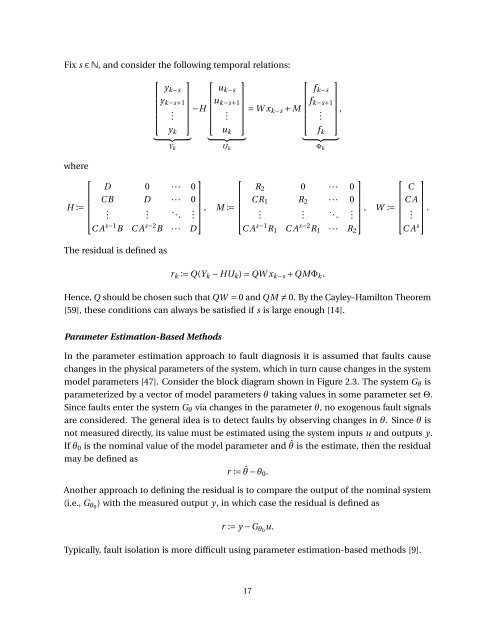Probabilistic Performance Analysis of Fault Diagnosis Schemes
Probabilistic Performance Analysis of Fault Diagnosis Schemes
Probabilistic Performance Analysis of Fault Diagnosis Schemes
Create successful ePaper yourself
Turn your PDF publications into a flip-book with our unique Google optimized e-Paper software.
Fix s ∈ N, and consider the following temporal relations:<br />
⎡<br />
⎢<br />
⎣<br />
y k−s<br />
y k−s+1<br />
.<br />
y k<br />
⎤<br />
} {{ }<br />
Y k<br />
⎡<br />
⎥−H<br />
⎢<br />
⎦ ⎣<br />
u k−s<br />
u k−s+1<br />
.<br />
u k<br />
⎤<br />
} {{ }<br />
U k<br />
⎡<br />
f k−s<br />
⎤<br />
f ⎥ = W x k−s + M<br />
k−s+1<br />
⎢ ⎥,<br />
⎦<br />
⎣ . ⎦<br />
f k<br />
} {{ }<br />
Φ k<br />
where<br />
⎡<br />
⎤<br />
D 0 ··· 0<br />
C B D ··· 0<br />
H :=<br />
⎢<br />
.<br />
⎣ . . .. ⎥ . ⎦ ,<br />
C A s−1 B C A s−2 B ··· D<br />
The residual is defined as<br />
⎡<br />
⎤<br />
R 2 0 ··· 0<br />
M := C R 1 R 2 ··· 0<br />
⎢<br />
.<br />
⎣ .<br />
. .. ⎥ . ⎦ ,<br />
C A s−1 R 1 C A s−2 R 1 ··· R 2<br />
⎡ ⎤<br />
C<br />
W := C A<br />
⎢ ⎥<br />
⎣ . ⎦ .<br />
C A s<br />
r k := Q(Y k − HU k ) = QW x k−s +QMΦ k .<br />
Hence, Q should be chosen such that QW = 0 and QM ≠ 0. By the Cayley–Hamilton Theorem<br />
[59], these conditions can always be satisfied if s is large enough [14].<br />
Parameter Estimation-Based Methods<br />
In the parameter estimation approach to fault diagnosis it is assumed that faults cause<br />
changes in the physical parameters <strong>of</strong> the system, which in turn cause changes in the system<br />
model parameters [47]. Consider the block diagram shown in Figure 2.3. The system G θ is<br />
parameterized by a vector <strong>of</strong> model parameters θ taking values in some parameter set Θ.<br />
Since faults enter the system G θ via changes in the parameter θ, no exogenous fault signals<br />
are considered. The general idea is to detect faults by observing changes in θ. Since θ is<br />
not measured directly, its value must be estimated using the system inputs u and outputs y.<br />
If θ 0 is the nominal value <strong>of</strong> the model parameter and ˆθ is the estimate, then the residual<br />
may be defined as<br />
r := ˆθ − θ 0 .<br />
Another approach to defining the residual is to compare the output <strong>of</strong> the nominal system<br />
(i.e., G θ0 ) with the measured output y, in which case the residual is defined as<br />
r := y −G θ0 u.<br />
Typically, fault isolation is more difficult using parameter estimation-based methods [9].<br />
17













